Abstract
Striga gesnerioides (Willd) Vatke, is a major destructive parasitic weed of cowpea (Vigna unguiculata (L.) Walp.) which causes substantial yield reduction in West and Central Africa. The presence of different virulent races within the parasite population contributes to significant genotype × environment interaction, and complicates breeding for durable resistance to Striga. A 3-year study was conducted at three locations in the dry savanna agro-ecology of Nigeria, where Striga gesnerioides is endemic. The primary objective of the study was to identify cowpea genotypes with high yield under Striga infestation and yield stability across test environments and to access suitability of the test environment. Data collected on grain yield and yield components were subjected to analysis of variance (ANOVA). Means from ANOVA were subjected to the genotype main effect plus genotype × environment (GGE) biplot analysis to examine the multi-environment trial data and rank genotypes according to the environments. Genotypes, environment, and genotypes × environment interaction mean squares were significant for grain yield and yield components, and number of emerged Striga plants. The environment accounted for 35.01%, whereas the genotype × environment interaction accounted for 9.10% of the variation in grain yield. The GGE biplot identified UAM09 1046-6-1 (V7), and UAM09 1046-6-2 (V8), as ideal genotypes suggesting that these genotypes performed relatively well in all study environments and could be regarded as adapted to a wide range of locations. Tilla was the most repeatable and ideal location for selecting widely adapted genotypes for resistance to S. gesnerioides.



Similar content being viewed by others
References
Asfaw A, Alemayehu F, Gurum M, Atha F (2009) AMMI and SREG GGE biplot analysis for matching varieties onto soybean pro-duction environments in Ethiopia. Sci Res Essays 4:1322–1330
Atokple IDK, Singh BB, Emechebe AM (1993) Independent inheritance of Striga and Alectra resistance in cowpea genotype B 301. Crop Sci 33:714–715
Badu-Apraku B, Lum AF, Akinwale RO, Oyekunle M (2011) Biplot analysis of diallel crosses of early maturing tropical maize inbreds in stress and nonstress environments. Crop Sci 51:173–188
Bebawi FF, Eplee RE, Harris CE, Norris RS (1984) Longevity of witchweed (Striga asiatica) seed. Weed Sci 32:494–507
Botanga J, Timko MP (2006) Phenetic relationships among different races of Striga gesnerioides (Wild) Vatke from West Africa. Genome 49:1351–1365
Bressani R (1985) Nutritive value of cowpea. In: Singh SR, Rachie KO (eds) Cowpea research, production, and utilization. Wiley, New York, pp 353–359
Conrath U (2011) Molecular aspects of defence priming. Trends Plant Sci 16:524–531
Cooper M, Byth DE (1996) Understanding plant adaptation to achieve systematic applied crop improvement a fundamental challenge. In: Cooper M, Hammer GL (eds) Plant adaptation and crop improvement. CABI Publishing, Wallingford, pp 5–23
DeVries JD (2000) The inheritance of Striga reactions in maize. In: Haussmann BIG et al (eds) Breeding for Striga resistance in cereals. Proc of a Workshop, IITA, Ibadan, Nigeria, 18–20 Aug 1999. Margraf Verlag, Weikersheim, pp 73–81
Dugje IY, Kamara AY, Omoigui LO (2006) Infestation of crop fields by Striga species in the savannas of northeast Nigeria. Agric Ecosy Environ 116:251–254
Emechebe AM, Singh BB, Leleji OI, Atokple IDK, Adu JK (1991) Cowpea Striga problems and research in Nigeria. In: Kim SK (ed) Combating Striga in Africa, proceedings of an international workshop organised by IITA, ICRISAT and IDRE. IITA, Ibadan, pp 18–28
FAOSTAT (2017) Agricultural production data in 2017. www.fao.org/faostat/en/data/QC
Fox PN, Rosielle AA (1982) Reducing the influence of environmental main-effects on pattern analysis of plant-breeding environments. Euphytica 31:645–656
Haussmann BIG, Hess DE, Welz HG, Geiger HH (2000) Improved methodologies for breeding Striga resistance sorghums. Field Crops Res 66:195–211
Haussmann BIG, Hess DE, Reddy BVS, Mukuru SZ, Kayentao M, Welz HZ, Geiger HH (2001) Pattern analysis of genotype × environment interaction for Striga resistance and grain yield in African sorghum trials. Euphytica 122:297–308
IITA (1982) Automated and semi-automated methods for soil and plant analysis. Manual series no. 7. International Institute of Tropical Agriculture, Ibadan
Institute SAS (2001) Statistical analysis software (SAS): users guide. SAS Inst. Inc., Cary, NC
Ito D, Afshar RK, Chengci C, Miller P, Kephart K, McVay K, Lamb P, Miller J, Bohannon B, Knox M (2016) Multi-environmental evaluation of dry pea and lentil cultivars in Montana using the AMMI model. Crop Sci 56:520–529
Joel DM, Hershenhorn J, Eizenberg H, Aly R, Ejeta G, Rich PJ, Ransom JK, Sauerborn J, Rubiales D (2007) Biology and management of weedy root parasites (invited review). In: Janick J (ed) Horticultural reviews, vol 33. Wiley, Hoboken, pp 267–350
Kang MS (2002) Quantitative genetics, genomics, and plant breeding. CABI, Wallingford
Keyes WJ, Taylor JV, Apkarian RP, Lynn DG (2001) Dancing together social controls in parasitic plant development. Plant Physiol 127:1508–1512
Kim SK, Adetimirin VO, Dossou R (2002) Yield losses in maize due to Striga hermonthicain West and Central Africa. Int J Pest Manage 48:211–217
King SB, Zummo N (1977) Physiologic specialization in Striga hermonthicain West Africa. Plant Dis Rep 61:770–773
Lane JA, Child DV, Reiss GC, Entcheva V, Bailey JA (1997) Crop resistance to parasitic plants. In: Crute IR et al (eds) The gene-for-gene relationship in plant parasite interactions. CAB Int, Wallingford, pp 81–97
Madden LV, Hughes G, Van den Bosch F (2007) The study of plant disease epidemics. APS Press, St. Paul
Menkir A, Jorge F, Adegoke A, Bossey B (2012) Evaluating consistency of resistance reactions of open-pollinated maize cultivars to Strigahermonthica (Del.) benth under artificial infestation. Crop Sci 52:1051–1060
Odhiambo GD, Ransom JK (1994) Long term strategies for Striga control. In: DC Jewell et al (eds) Maize research for stress environments. Proc Eastern and Southern Africa Regional Maize Conf, 4th, Harare, Zimbabwe, 28 Mar–1 Apr 1994. CIMMYT, Harare, pp 263–266
Omoigui LO, Kamara AY, Ishiyaku MF, Ousmane B (2012) Comparative responses of cowpea breeding lines to Striga and Alectra in the dry savanna of northeast Nigeria. Afr J Agric Res 7(5):747–754
Ransom JK, Eplee RE, Langston MA (1990) Genetic variability for resistance to Strigaasiatica in maize. Cereal Research Communic 329–333
Shaxson L, Riches C (1998) Where once there was grain to burn: a farming system in crisis in eastern Malawi. Outlook Agric 27:101–105
Singh BB, Emechebe AM (1997) Advances in research on cowpea Striga and Alectra. In: Singh BB et al (eds) Advances in cowpea research. IITA, Ibadan, pp 215–224
Singh BB, Emechebe AM, Ransom JK, Museliman LJ, Warshan DA, Parker C (1991) Breeding cowpea varieties for resistance to Strigagesnerioides and Alectravogelii. In: Ransom JK et al (eds) Proceeding 5th international symposium on parasitic weeds, 24–30 June, 1991, Nairobi, Kenya. CIMMYT DF, Mexico
Tarawali SA, Singh BB, Peters M, Blade SF (1997) Cowpea haulms as fodder. In: Singh BB et al (eds) Advances in cowpea research. Co-publication of IITA and JIRCAS, Sayce, Devon, pp 313–325
Turkensteen LJ (1993) Durable resistance of potatoes against Phytophthorainfestans. In: Jacobs T, Parlevliet JE (eds) Durability of disease resistance Dordrecht, the Netherlands. Kluwer Academic Publishers, Dordrecht, pp 115–124
Vogt W, Sauerborn J, Honisch M (1991) Striga hermonthica distribution and infestation in Ghana and Togo on grain crops. In: Ransom et al (eds) Proceedings of the fifth international symposium on parasitic weeds. CIMMYT, Nairobi, pp 372–377
Worsham AD (1987) Germination of witchweed seeds. In: Musselman LJ (ed) Parasitic weeds in agriculture, vol I. CRC Press, Boca Raton, pp 45–61
Xu NY, Zhang GW, Li J, Zhou ZG (2013) Ecological regionalization of cotton varieties based on GGE biplot. Chin J Appl Ecol 24:771–776
Ouedraogo JT (2012) Development of sequence characterized amplified region (SCAR) markers linked to race-specific resistance to Strigagesnerioides in cowpea (Vigna unguiculata L.). Afr J Biotechnol 11(62):12555–12562
Yan W (2001) GGE biplot-a Windows application for graphical analysis of multi-environment trial data and other types of two-way data. Agron J 93:1111–1118
Yan W, Holland JB (2010) A heritability-adjusted GGE biplot for test environment evaluation. Euphytica 171(3):355–369
Yan W, Hunt LA (2001) Interpretation of genotype × environment interaction for winter wheat yield in Ontario. Crop Sci 41:19–25
Yan W, Hunt LA (2002) Biplot analysis of diallel data. Crop Sci 42:21–30
Yan W, Kang MS (2003) GGE biplot analysis: a graphical tool for breeders, geneticists, and agronomists. CRC Press, Boca Raton
Yan W, Tinker NA (2006) Biplot analysis of multi-environment trial data: principles and applications. Can J Plant Sci 86:623–645
Yan W, Hunt LA, Sheng Q, Szlavnics Z (2000) Cultivar evaluation and mega-environment investigation based on the GGE biplot. Crop Sci 40:597–605
Yan W, Kang MS, Ma B, Woods S, Cornelius PL (2007) GGE biplot vs. AMMI analysis of genotype-by-environment data. Crop Sci 47:643–655
Zhang ZF, Fu XF, Liu JQ, Yang HS (2010) Yield stability and testing-site representativeness in national regional trials for oat variety based on GGE-biplot analysis. Acta Agron Sin 36:1377–1385
Acknowledgments
The authors are grateful to the staff of UAM Cowpea Breeding unit for providing technical support. The research was funded by Kirkhouse Trust UK (grant number 01) through financial grant to the Cowpea Breeding in Nigeria using Molecular Tools of the University of Agriculture Makurdi, Nigeria.
Author information
Authors and Affiliations
Corresponding author
Ethics declarations
Conflict of interest
The authors declared that they have no conflict of interest
Rights and permissions
About this article
Cite this article
Omoigui, L.O., Kamara, A.Y., Ajeigbe, H.A. et al. Performance of cowpea varieties under Striga gesnerioides (Willd.) Vatke infestation using biplot analysis. Euphytica 213, 244 (2017). https://doi.org/10.1007/s10681-017-2034-x
Received:
Accepted:
Published:
DOI: https://doi.org/10.1007/s10681-017-2034-x




